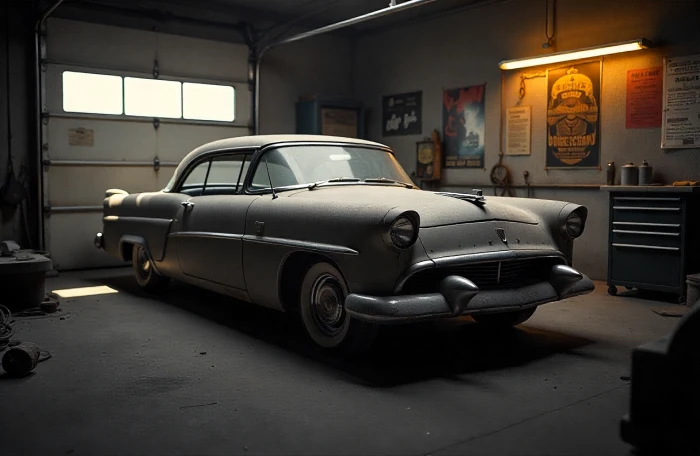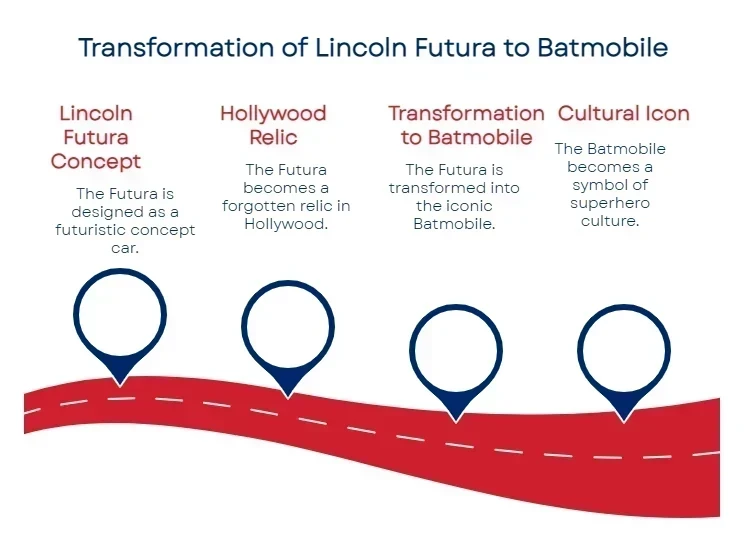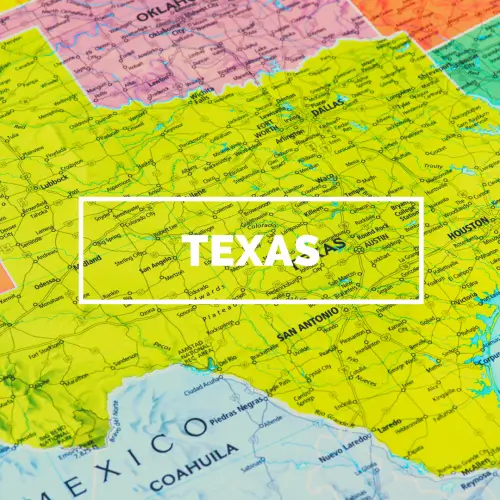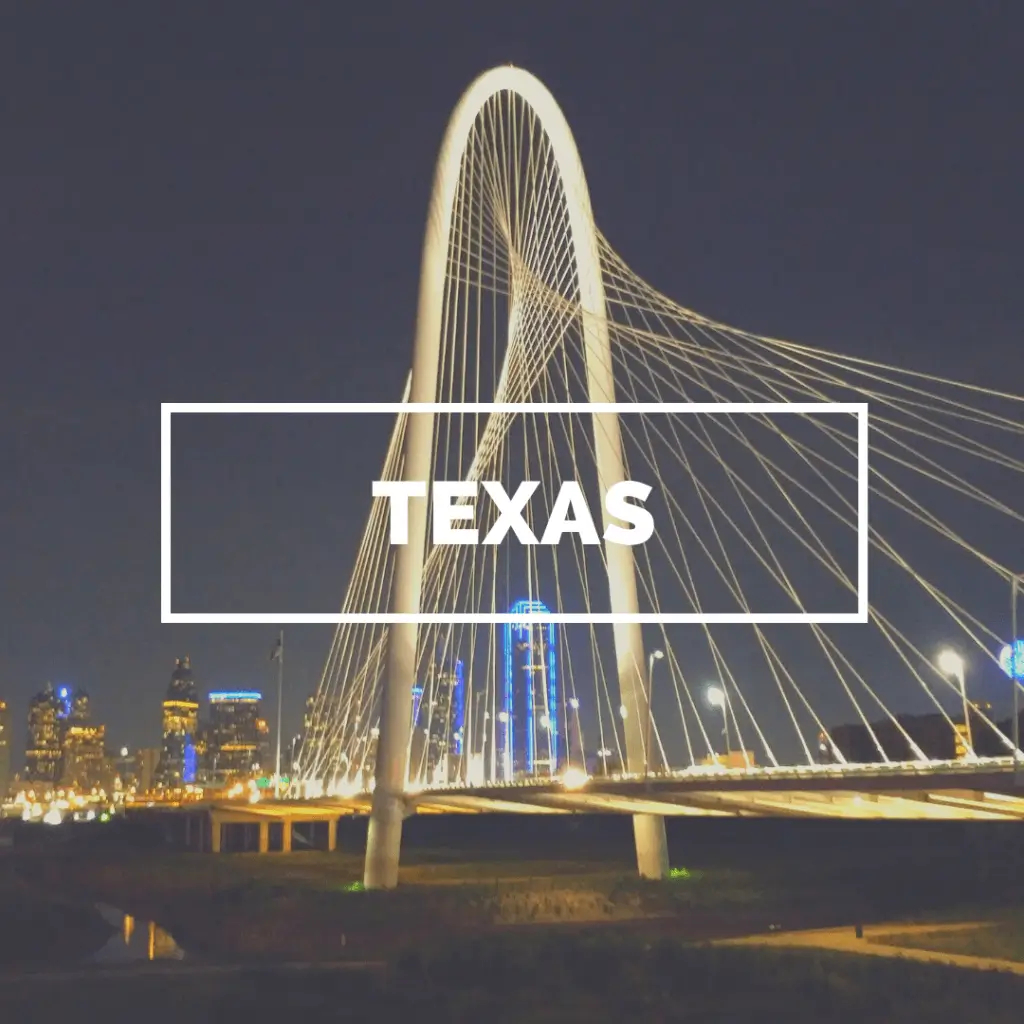A Shark-Inspired Show Car That Became a Superhero’s Steed
Remember the moment Batman raced out of the Batcave, cape fluttering, behind the wheel of a jet-black car with glowing red outlines and fin-like wings? For many fans, that moment wasn’t just about the hero; it was about the car. The Batmobile car wasn’t an accessory. It was an icon. Bold. Mysterious. Unlike anything on the road.
But before it ever cruised the streets of Gotham, the Batmobile was something else entirely: the Lincoln Futura, a 1955 concept car that looked more like a spacecraft than a sedan. With bubble canopies and fish-scale paint, it wasn’t built for crime-fighting. It was built to drop jaws.
From a nearly forgotten Hollywood relic to the most famous superhero car in history, the transformation of the Futura is a tale of inspiration, reinvention, and cultural legend.
The Origins of the 1955 Lincoln Futura
The 1955 Lincoln Futura, a visionary concept car, debuted at the 1955 Chicago Auto Show, captivating audiences with its futuristic design. Crafted by Ghia in Turin, Italy, for $250,000 (over $2.9 million today), it featured a pearlescent Frost-Blue finish, a double-dome canopy, and a 368-cubic-inch V8 engine. Inspired by designer Bill Schmidt’s scuba-diving encounter with a shark, its sleek lines and canted tailfins embodied 1950s optimism. The Futura’s Batmobile history began a decade later, but its initial role as a showstopping concept laid the foundation for its iconic status, appealing to collectors seeking rare classic car value.
What You’ll Learn
Here’s what you’ll find in this post:
How the 1955 Lincoln Futura became the Batmobile Car
What made the Batmobile so iconic, from design to gadgets
Where the original Batmobile is today, and how much it sold for
Overview: The Features and Moments That Turned the Futura into the Batmobile Car
The Batmobile Car, originally the 1955 Lincoln Futura, is one of the most recognized vehicles in pop culture history. It began as a futuristic concept car with a shark-inspired design and eventually transformed into the iconic car used in the 1960s Batman television series. Over time, it went from a forgotten film prop to a high-dollar collectible, selling for millions at auction. What makes this car so legendary goes far beyond its fins and gadgets. Its story is a mix of design genius, Hollywood magic, and childhood dreams turned real.
Here's a more detailed breakdown:
Origins and Concept Design
The Lincoln Futura was designed in the early 1950s by Bill Schmidt and John Najjar. Inspired by a shark encounter in the Caribbean, it featured a double bubble canopy, oversized tailfins, and a pearlescent finish made from fish scales.
Built by Hand in Italy
Ford sent the design to Italian coachbuilder Carrozzeria Ghia. The one-off car cost $250,000 to build and took three months to complete. It was fully drivable and packed with custom features for its time.
Early Fame in Hollywood
Before becoming the Batmobile, the Futura made its debut in the 1959 film It Started with a Kiss, starring Debbie Reynolds and Glenn Ford. The car was repainted red for the movie.
Barris’s $1 Transformation
George Barris bought the Futura from Ford for $1. He later turned it into the Batmobile for the 1966 TV series. With just 15 days and $15,000, Barris reshaped the car to fit Batman’s crime-fighting world.
Batmobile Features
The finished car had rear fins shaped like bat wings, a nose that resembled a bat’s face, and various mock gadgets, including a Batphone, smoke screen, and oil slick sprayers.
Cultural Impact
The Batmobile appeared in all 120 episodes of the Batman series. It became a merchandising hit and one of the most beloved cars on TV, spawning model kits, toys, and fan replicas.
Auction Sale and Legacy
In 2013, the original Batmobile sold at auction for $4.62 million. Its story still inspires car lovers, designers, and Batman fans alike.
How the Futura Became the Batmobile
In 1965, Hollywood customizer George Barris transformed the 1955 Lincoln Futura into the Batmobile for the 1966–1968 Batman TV series. Purchased from Ford for just $1, the Futura’s bat-like styling made it the perfect base. With only three weeks to meet the studio’s deadline, Barris and metalworker Bill Cushenbery added Batmobile gadgets like a smoke emitter, rear parachutes for “bat-turns,” and a gloss-black paint job with red accents. The transformation, costing $30,000, created a cultural icon, with the original selling for $4.62 million in 2013. This Batmobile history underscores its enduring appeal for fans and collectors.
Iconic Batmobile Gadgets That Stole the Show
The Batmobile gadgets defined the Lincoln Futura’s transformation into a crime-fighting legend. Key features included:
Revolving License Plates: Switched between multiple plates for stealth.
Chain Slicer: Cut through obstacles during high-speed chases.
Batphone: A dashboard-integrated communication device.
Parachutes: Enabled dramatic 180-degree turns.
Smoke Emitter: Obscured pursuers for quick escapes.
These theatrical additions, paired with the Futura’s sleek design, made the Batmobile a fan favorite, enhancing its classic car value for collectors seeking replicas or display models with functional Batmobile gadgets.
The Collector’s Appeal of the Lincoln Futura Batmobile
The 1955 Lincoln Futura holds immense classic car value due to its rarity and pop culture significance. The original, now a $4.62-million auction star, is unattainable for most, but replicas offer accessible alternatives. Fiberglass copies, like those built by Barris on Ford Galaxie chassis, and modern recreations by enthusiasts like Mark Towle of Gotham Garage, capture the Futura’s essence. Collectors prize these for their Batmobile history, with prices ranging from $25,000 for basic replicas to over $2.75 million for limited-edition builds. Verifying authenticity via documentation ensures lasting value for enthusiasts.
Tips for Buying a Lincoln Futura or Batmobile Replica
For those eyeing a 1955 Lincoln Futura replica or Batmobile-inspired build, careful preparation maximizes investment value:
Verify Provenance: Confirm the replica’s builder and documentation, especially for Barris or Butts models.
Inspect Build Quality: Check fiberglass integrity and gadget functionality for authenticity.
Test Mechanicals: Ensure the chassis (often Ford Galaxie-based) and engine run smoothly.
Research Market Value: Compare prices on platforms like eBay to avoid overpaying.
Plan for Maintenance: Source parts for 1950s Lincoln or 1960s Galaxie components to keep costs manageable.
These steps ensure buyers secure a piece of Batmobile history with strong classic car value.
Shipping Your Batmobile or Futura Replica Safely
Transporting a 1955 Lincoln Futura replica or Batmobile requires precision to protect its classic car value. AmeriFreight’s vintage car shipping services offer enclosed carriers to shield the vehicle’s pearlescent finish or iconic black-and-red livery from weather and debris. Our door-to-door delivery ensures your Batmobile arrives ready for display or cruising, whether it’s a collector’s original or a custom build. Trust AmeriFreight to handle your vintage car shipping needs with care, preserving the legacy of this iconic ride. Get a free quote today to bring your Batmobile home.
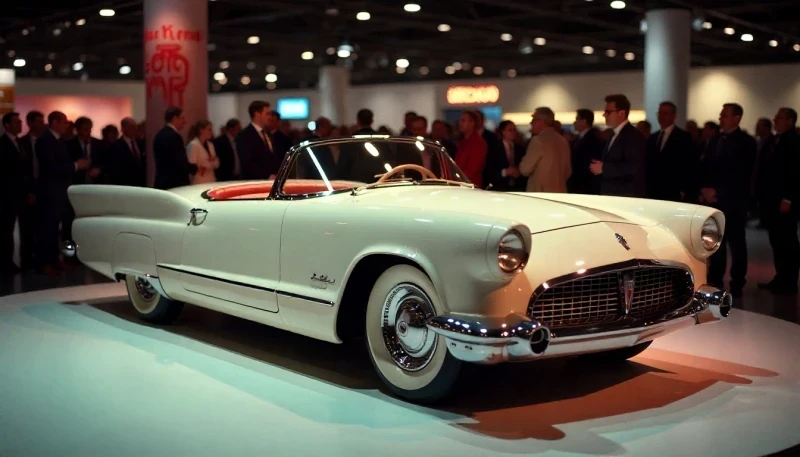
Born Underwater: The Design That Started It All
In 1952, Ford designer Bill Schmidt went diving in the Caribbean and came face-to-face with a shark. That brush with nature shaped the future. Inspired by the shark’s sleek form and quiet power, Schmidt and his colleague John Najjar designed the Lincoln Futura, a car that would resemble something from science fiction.
Built by master artisans at Carrozzeria Ghia in Turin, the Futura took three months to complete and cost a staggering $250,000. With its low profile, steel body, bubble canopy, and iridescent finish made from crushed fish scales, the Futura was more than a car. It was a spectacle.
And yet, after dazzling audiences at auto shows and appearing in the 1959 film It Started with a Kiss, it disappeared from the spotlight until fate gave it another chance.
Gotham-Ready: The Reinvention of the Century
Producers of the upcoming Batman TV series faced a challenge in 1965: they urgently needed a Batmobile. With a tight 15-day deadline and a modest $15,000 budget, Barris had a secret weapon: the Lincoln Futura, which had been gathering dust since he purchased it for just one dollar.
He saw its potential instantly. The frame was already futuristic. The curves were already comic-book-worthy.
Barris and his team worked around the clock. They extended the fins to mimic bat wings, reshaped the front into a bat-like snout, added a faux jet turbine, and painted it gloss black with red accents. The result? A car that looked ready to battle villains and tear through the streets of Gotham.
Superhero Specs: The Batmobile’s Legendary Features
Although many of its gadgets were props, the Batmobile appeared to be a crime-fighting machine straight out of a dream. Here’s what made it stand out:
From Concept to Collectible: Real-World Batmobile Replicas
The Batmobile wasn’t just a hit on-screen; it ignited something in real life, too. That sleek, winged machine from the 1966 Batman TV show captured imaginations and made people dream about driving it off the screen and into their garage. Over the years, that dream became reality.
From legendary builders to passionate fans, the Batmobile has been reborn dozens of times. Some versions are museum-grade showpieces. Others are weekend projects that roar to life in garages and backyards. All of them prove one thing: this car never stopped inspiring.
George Barris’ Original Batmobile Replicas
The story starts with George Barris, the man who transformed the Lincoln Futura into the first Batmobile. But he didn’t stop at just one. To keep up with the car’s rising popularity, Barris built three additional fiberglass replicas using molds taken from the original.
These versions toured the country in the 1960s and 1970s, showing up at parades, fairs, and conventions. They didn’t just look the part; they became part of the Batmobile’s lore, helping turn it from a one-off prop into a rolling legend.
The $4.6 Million Dream Car
In 2013, the original #1 Batmobile, built from the Lincoln Futura, went up for auction and fetched a jaw-dropping $4.62 million to Rick Champagne, a lifelong Batman fan who had once owned the toy version as a child. Now, he had the real thing.
The sale didn’t just set records. It cemented the Batmobile’s place as one of the most iconic and valuable vehicles in entertainment history.
Fiberglass Freaks: The Official Modern Builders
Today, if you want a street-legal Batmobile, there’s one name you need to know: Fiberglass Freaks. Based in Indiana and run by builder Mark Racop, this shop is officially licensed by DC Comics to produce full-scale replicas of the 1966 Batmobile.
Every detail is faithful, from the red-trimmed bat fins to the working flamethrower in the rear exhaust. These builds include modern features such as GPS, Bluetooth, and high-performance engines, all wrapped in a nostalgic comic book aesthetic. They don’t come cheap; prices can reach well into six figures, but for collectors, they’re as close to the Batcave as you can get.
Pop Culture Impact: How the Batmobile Changed Everything
The Batmobile didn’t just enhance a TV show. It became a blueprint for how fictional vehicles could live beyond the screen. Its bold look and gadget-filled mystique inspired future superhero cars, science fiction design, and toy lines for generations.
Elements of the Futura’s design — such as tailfins, grille patterns, and canopy styling — found their way into real cars, influencing models like the 1960 Mercury Monterey and the Ford Galaxie.
More importantly, the Batmobile sparked imagination. It showed that cars could be characters and that machines could be art. Something built for one purpose can become something entirely new when given the right story.
Ready to Drive Into Legend?
The Batmobile proves that design, timing, and imagination can turn a nearly forgotten prototype into a pop culture juggernaut. What started as a concept car inspired by a sketch of a shark now lives on in museums, collections, and the hearts of fans everywhere.
If you’re inspired to start your classic car journey, whether you’re restoring a dream machine or relocating your favorite ride, AmeriFreight Auto Transport can help you get there.
We specialize in arranging transportation with vetted carriers nationwide, experienced in handling collectible vehicles, customs, and everyday drivers. Choose between open and enclosed transport—no capes required.
Frequently Asked Questions (FAQs)
What is the Batmobile Car?
The Batmobile Car is the 1955 Lincoln Futura concept car, later customized for the 1966 Batman TV series.
Who designed the original Lincoln Futura?
Ford stylists Bill Schmidt and John Najjar created the design, inspired by a shark encounter in the Caribbean.
Where was the Lincoln Futura built?
It was hand-built by Carrozzeria Ghia in Italy for $250,000.
How did the Lincoln Futura become the Batmobile?
Hollywood customizer George Barris bought it for $1 and transformed it into the Batmobile in just three weeks.
Was the Batmobile a real working car?
Yes. The Batmobile was fully roadworthy, although many of the iconic gadgets, such as the Batphone or smoke screen, were TV props.
How much did the original Batmobile sell for?
It sold at auction in 2013 for $4.62 million to Rick Champagne, a lifelong fan of the car.
Disclaimer: This article is for informational and entertainment purposes only. The Batmobile Car is a fictional vehicle from a television series, and while some replicas exist, they are not affiliated with the original creators or licensed properties. Any references to custom builds or fan-made projects are based on publicly available information and are not endorsements. Always consult a qualified professional before attempting any automotive modifications or large-scale vehicle builds.


